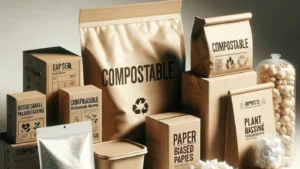In an generation of developing environment awareness, the food packaging enterprise faces growing stress to undertake sustainable practices. Technology performs a pivotal function in creating innovative, eco-friendly options to limit waste, reduce environmental impact, and meet purchaser demand for greener alternatives.

The Problem with Traditional Packaging
Conventional food packaging, frequently made from plastic or composite materials, contributes notably to international pollution. Plastic packaging, in particular, is non-biodegradable, main to overflowing landfills, marine pollution, and threats to wildlife. According to the United Nations Environment Programmer (UNEP), about three hundred million lots of plastic waste is produced annually, with meals packaging being a predominant contributor.
Emerging Technologies in Eco-Friendly Packaging
Biodegradable Materials
Advances in cloth science have led to the improvement of biodegradable preferences to plastic, such as polylactic acid (PLA) made from corn starch, or polyhydroxyalkanoates (PHAs) derived from microorganisms. These substances decompose naturally, lowering the burden on landfills and stopping microplastic pollution.
Edible Packaging
Edible packaging, made from herbal elements like seaweed, rice, or potato starch, is a state-of-the-art innovation. Startups like Notpla and Evoware are developing fit for human consumption sachets and wraps for meals and beverages, supplying a zero-waste solution.
Smart Packaging
Technology allows the introduction of clever packaging that enhances sustainability whilst extending shelf life. Sensors embedded in packaging substances can display temperature, humidity, or freshness, decreasing meals spoilage and waste. This innovation additionally lets in businesses to use thinner substances whilst maintaining product integrity.
Recycled and Upcycled Materials
Recycling technological know-how has superior to produce awesome food-grade substances from post-consumer waste. For example, PET (polyethylene terephthalate) can be recycled into new packaging with minimal environmental impact. Additionally, upcycling agricultural by-products, such as wheat straw or sugarcane bagasse, affords eco-friendly packaging options.
3D Printing
Additive manufacturing applied sciences like 3D printing allow the manufacturing of custom, lightweight, and sustainable packaging on demand. This minimizes waste, reduces delivery costs, and permits for higher plan flexibility.
Challenges and Considerations
Despite technological advancements, eco-friendly meals packaging faces challenges:
Cost: Sustainable substances and superior manufacturing methods can be extra pricey than typical methods.
Performance: Biodegradable and fit to be eaten packaging might also have obstacles in phrases of sturdiness or moisture resistance.
Infrastructure: A lack of composting or recycling amenities in many areas limits the effectiveness of these solutions.
The Role of Policy and Collaboration
Governments and agencies play a indispensable position in using change. Regulatory measures like bans on single-use plastics, subsidies for sustainable packaging R&D, and public recognition campaigns can speed up the adoption of eco-friendly alternatives. Collaborative efforts amongst scientists, enterprise players, and policymakers can additionally foster innovation and scale production.
Future Prospects
The intersection of science and sustainability guarantees interesting trends in meals packaging. Nanotechnology, for instance, is being explored for its manageable to create ultra-thin, biodegradable movies with better barrier properties. Similarly, AI and desktop gaining knowledge of can optimize furnish chains to decrease waste further.
Conclusion
Technology is revolutionizing the meals packaging enterprise by enabling the improvement of eco-friendly options that align with the standards of a round economy. By embracing innovation, overcoming challenges, and fostering collaboration, society can mitigate the environmental influence of meals packaging and go nearer to a sustainable future.
